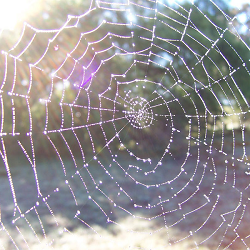I am working on producing a new class of “smart materials” based on proteins, the complex molecules that are the building blocks of life. While proteins have evolved over billions of years to perform a huge range of functions, from digestive enzymes to tiny yet powerful motors, designing new functional proteins from scratch is still a largely unsolved problem. To produce new and useful protein-based materials, we need to take inspiration from nature.
The material I am working on is based on two components. The first component is repeat proteins, a type of protein which is made of “stacks” of several similar units. They tend to have a long, narrow shape and look and act like elastic springs. While we cannot design a protein from the ground up, many features of a repeat protein can be changed by design. In living organisms, these proteins act to bind molecules and hold them together, so they could be used to bind drug molecules and release them when the spring was stretched.
However, this poses another problem- how to stretch the spring and release the drug molecule. as it’s obviously not possible to simply grab hold of the ends of the protein and pull. The nano-scale proteins need to somehow be connected to a material that exists, and can be affected, on the human scale. One way to do this is to make them components of a network- and this is where the spider webs come in.
Spider silk is the toughest natural material known, and is made entirely out of proteins called spidroins. It gets its toughness from the way that it is composed of some elastic, disordered regions and others that are crystalline and extremely strong. I plan to fill the role of the crystalline part of the material with amyloid fibrils.
Amyloid fibrils are very strong fibres that are formed from many protein molecules sticking together, or aggregating, to assemble themselves into long, thin structures. They are familiar to many people because they have been found in the brains of patients with diseases such as Alzheimer’s and Parkinson’s. However, it is now thought that they are a symptom rather than a cause of these diseases, and there are many situations where they are biologically useful.
I use chemical methods based on non-standard amino acids (not part of the 20 which form most natural proteins) to physically link repeat proteins and amyloid fibres together to form an extended network. This will be an extremely tough yet flexible material which will be able, for example, to be used in an implant that releases a drug molecule when it comes under stress.
Alexander Guttenplan
NanoDTC PhD Student Cohort 2012
Department of PharmacologyItzhaki group, PharmacologyKnowles Group, ChemistryImage: “Dewy spider web”. Licensed under CC BY-SA 3.0 via Wikimedia Commons – https://commons.wikimedia.org/wiki/File:Dewy_spider_web.jpg

